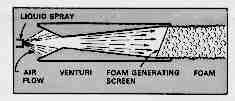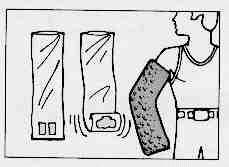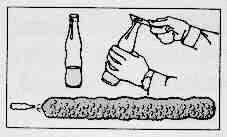
 Scientific American foam ad Sep 73
Scientific American foam ad Sep 73
Few technologists who wet their noses in the collar on a cold beer or squirt an extinguisher on a lab bench blaze give more than a passing thought to the foam. But Monsanto researchers were handed a contract research problem. The culprit was coal dust. The client wanted it trapped and contained � as it billowed out from the cutting bits of continuous miners that chewed tons-per-minute bites from a coal seam. An atomized water spray didn't trap enough; too much dangerous micronized coal dust escaped. A far better way was needed to suppress the 5 micron and smaller particles.
Monsanto researchers opted for foam. Their main objective: develop high expansion foam materials, simulate application, and evaluate effectiveness. This started a program that created a wide and beguiling variety of aqueous foams. One of them, a polymer-augmented water-base foam, did the entrapment job on coal dust. Did it very well indeed. The parent liquid contained 990 parts water, 5 parts detergent, 5 parts polyelectrolyte resin. Its expansion ratio was 200:1. In the coal-cutting laboratory set-up, dust-laden air containing 70 million particles per cubic foot was 99% clarified � down to 0.5 mppcf. And small amounts of the foam-making liquid went a surprisingly long way. Just 35 ml per minute foamed over the cutting head of the laboratory "miner" suppressed 84% of the coal dust. Increased rates brought the clarification up to the 95-99% range. The stability of the foam was adjusted to entrap the dust, then collapse and drain away � to avoid flooding the working face. And the polyelectrolyte cemented the dust particles together, preventing re-aerosolization.
Coal dust studies heightened Monsanto researchers' fascination with foams, foam-making formulations, and ways to froth them. A bevy of intriguing possibilities surfaced. Along with recipes, a number of ingenious mechanical systems for turning liquids to foam were developed, including portable carry-anywhere devices. The combination of formulation and foam-making hardware sparked a gamut of why-didn't-we-think-of-that-before-ideas for foams.
Pursuing their unique utility, Monsanto researchers explored foams down three avenues: "temporary disposable," "long-lasting" and "permanent" foams. From the accumulated know-how a remarkable range of foams can now spew forth to do an incredible range of jobs.
With only air as the blowing agent, polymer-augmented aqueous foam solutions can be made that possess an expansion ratio as high as 1000:1 or as low as 50:1. Formulation controls the strength of the tiny bubbles, their wetting power, and the permanence of the foam. Water-based foams could be made to disappear with scarcely a trace in minutes, an hour or a day; others, under the proper conditions, could last for six months.
 |
| Where air blowing power is unavailable, an aspirating device has been developed that can propel 4'-5' projections of aqueous foam with expansion ratios up to 250:1. |
Speculation on possible commercial uses (the arbiter of both formulations and application devices) grew apace with the growing foam technology. Would not a foam formulated to last a few days be an excellent insulator to protect crops against frost? Or a weather-protecting coating for haystacks? Loaded with fire retardant � foam might be a way to lay down a fire break in the path of forest fires. Why not use foam blankets � tailored for particle entrapment � to halt wind erosion of outside-stored sulfur, to stabilize fly ash piles, or as a fast-disappearing cover to suppress dust fly-away from particulates moved by belts, chutes or conveyors. A foam blanket containing polyelectroly[t]e ought to stabilize raw soil shoulders of highways and runways. The ideas grew
12
More intriguing application ideas were sparked by "carrier foams." Such foams could disperse powders or liquids and make visible the area covered. They could be made with predetermined degrees of permanence, formulated to carry insectides, plant growth regulators, miticides, pest repellants. A long-lasting carrier might be the most practical way to combat dust film that frustrates herbicide contact in roadside weed control � or � the easiest-applied barrier on peach tree trunks against borers. An insecticidal carrier foam might be ideal to hold the toxicant to the bodies of hard-to-spray pests like grasshoppers.
The inquiry spill-over from aqueous to polymer foams was a natural progression. These were permanent structures � essentially gases immobilized as cells in plastic web. Study in depth showed these, too, were almost infinitely versatile. Commercial polystyrene and polyurethane foams, although major Monsanto-developments, hardly scratched the surface. Experimental work on new foams disclosed, for example, that a polyurethane block
 |
| Two special polyurethane components, separately pouch-packed in a "sleeve," can be mixed manually to react in less than 30 seconds to make a rigid, encapsulating splint. Or nozzle-fed to fill a shipping case. |
But more pioneering study soon developed a whole range of other "glamour" foams with unique properties: instant foams, "trowellable" air-frothed epoxy, fire resistant ureaformaldehyde and polymide foams. The polymer, its modification, cell shape, entrapped gas, etc. gave hundreds of structures. With various "tailorings," these foams' potential utility appears to be limitless.
"Instant foams" (made of polystyrene, SAN, PVAc, or other thermoplastics) are in essence "foams-that-shoot-from-a-bottle." Liquefied gas and low boiling solvents are the key. The liquid formulation under nominal pressure is uncorked (or valve-released). Instantly! it spews out as dry, solid foam ... with choice of density from 0.8 to 3 lbs./cu. ft. No mixing, no chemical reaction, no foaming machine � literally, instant foam � rigid or flexible � in liquid form. Here, certainly is Step 1 in creating encapsulating packaging-portable for field use or nozzle-dispensed over fragile products on the production line. The instant foams can inflate a punctured tire; form big, big light moldings; make instant pontoons and life rafts; create containment barriers around oil spills or make triggered flotation devices against boat hull puncture.
"Trowellable" air-frothed epoxies were investigated that offered new virtues to construction. These foams, made with a standard commercial resin plus a specially developed amine curing agent, could be frothed with air in kitched blender to make rigid 20-30 lb./cu. ft. foam or under 200 psi pressure to densities as light as 4 lb./cu. ft. The foams could be shoveled, squeegeed, pressure-fed. They supported themselves on vertical surfaces.
For structural uses, these epoxy foams � aside from handling ease and high support strength � also offered great durability, high moisture resistance, high temperature endurance, and better aging. They appear to be a most practical material for "quick-built" shelters, roofing for dwellings in developing countries, even complete structural members for basic housing. The high strength of these air-frothed epoxies solved a tough packaging problem: the shipping of large damage-
 |
| A laboratory demonstration with 2 oz. of "instant foam" in a soft drink bottle instantly projects a 6-ft., 6" dia. "spew" of rigid or elastomeric foam when uncapped. |
The air-frothing technique worked, too, with concentrated aqueous solutions of urea-formaldehyde � to produce certainly the world's lowest cost, lightest weight, fire-resistant rigid foam. It could weigh as little as 0.6 lb./cu. ft.
With heat resistance and flame retardance as a goal, Monsanto Research next turned to polymimides as the polymer. The result was a process and formulations that produce a series of new resilient foams, readily moldable, that possess tough non-abrading skins. These range from 2 to 8 lbs./cu. ft.; they are fire resistant (even in O2 enriched atmosphere) and will withstand temperatures of 600*************F for up to 100 hours. Here possibly is the ultimate in foams for aircraft cabins and material for high temperature insulation.
Monsanto researchers are convinced that foams merited the years of study, much of it contract research on designing foams for specific applications. They are certain of two things: there are lots of jobs for foams and they have a head-start on the know-how to make a foam for any job.
|
For further details, request a copy of: FOAMS, Types, Characteristics, Applications.
Address inquiries to: Dr. Ival O. Salyer Monsanto Research Corporation Station B, Box 8 Dayton, Ohio 45407 Tel.: (513) 268-3411 |
13